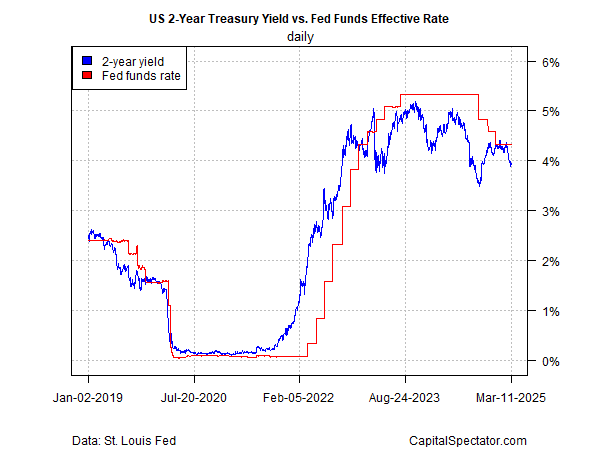The Federal Reserve may continue to be patient before deciding on the next change in monetary policy, but the Treasury market isn’t waiting and has been rapidly adjusting to changing expectations for the economy that reflect forecasts of weaker growth, or worse.
The policy-sensitive 2-year Treasury yield, which is seen as a market proxy for rate expectations, has fallen in recent weeks and is now pricing in higher odds that the central bank will reduce its target rate.
The 2-year yield traded at 3.94% yesterday (Mar. 11), close to the lowest level since October and well below the current 4.25% to 4.50 % Fed funds target range.
The drop in the 2-year yield marks a clear shift from earlier in the year, when this widely followed market rate was trading close to the Fed funds target rate. The narrow spread in previous weeks between the two rates implied that the bond market was expecting the Fed to keep interest rates steady for the near term. By contrast, the latest drop in the 2-year yield suggests that investors are now pricing in a higher chance for a rate cut.
What’s changed? Higher uncertainty for the economic outlook based on worries about the fallout from a trade war tops of the list of concerns. The Fed, however, is still expected to leave its 4.25%-to-4.50% target rate unchanged at the next policy meeting on Mar. 19, pricing in a 97% probability, based on futures data this morning. The confidence for no change, however, falls to roughly 66% for the May 7 FOMC meeting.
The Treasury market appears to be anticipating that a more dovish policy stance is brewing, based on the slide in the 2-year yield. A wild card that could reshuffle the outlook: today’s release of consumer prices for February, due shortly at 8:30 a.m. eastern.
“It’ll be really important that we don’t see an upside surprise on CPI because at this point, the Fed does have plenty of dry powder to step in to cut rates and try to boost demand if the economy were to meaningfully slow. But they can only really do that if they feel that inflation expectations and inflation are well anchored,” said Ross Mayfield, investment analyst at Baird.
Which stock should you buy in your very next trade?
With valuations skyrocketing in 2024, many investors are uneasy putting more money into stocks. Unsure where to invest next? Get access to our proven portfolios and discover high-potential opportunities.
In 2024 alone, ProPicks AI identified 2 stocks that surged over 150%, 4 additional stocks that leaped over 30%, and 3 more that climbed over 25%. That's an impressive track record.
With portfolios tailored for Dow stocks, S&P stocks, Tech stocks, and Mid Cap stocks, you can explore various wealth-building strategies.
